Digital public services: 4 proven steps to citizen-centric service delivery

Digital is the new face of the public sector. But many citizens believe that digital public services fall short and governments need to modernize service delivery fast. In this article, we summarize the latest research in public service delivery and user experience design to uncover 4 proven steps to create and improve superior citizen-centric digital public services.
Governments are the world’s largest service providers.
But when it comes to digital service delivery, the public sector consistently ranks below almost every other sector for customer satisfaction. As the private sector makes massive digitalization strides, the gap between private and public service delivery is ever-widening.
To close this gap, many governments are embracing a citizen-centric approach to digital public service delivery. The concept of citizen-centricity, or citizen experience optimization, follows in the footsteps of the private sector’s highly successful focus on customer experience optimization. Creating a citizen-centric experience is:
- One of the Organization for Economic Co-operation & Development's (OECD) top recommendations for improving public service delivery
- One of the current White House Administration’s top priorities for their tenure in U.S. leadership
- Commended in digital government awards by the U.N., EU, and The Economist
So if citizen-centricity is continually recognized as the path forward, why are digital transformation efforts in public service delivery still falling short?
In this article, we look at surveys, reports, studies, and real-world examples to explore the challenges in delivering effective and citizen-centric digital public services. We boil down the latest research in user experience design, digital transformation, and public service delivery to uncover 4 proven steps to create and improve citizen-centric digital public services.
Table of Contents
- What are citizen-centric digital public services?
- What are the benefits of citizen-centric digital public service delivery?
- What's the current state of public sector digital services?
- Foundational concepts for creating effective & trustworthy digital public services
- 4 proven steps to improve digital public services
- Summary: Successful digital transformation in the public sector
Prefer to watch? This blog is adapted from the information presented in the Carahsoft x Queue-it webinar Deliver a superior citizen experience no matter the demand. You can watch the webinar below or click the link here.
Citizen-centric digital public services are services that are simple, reliable, accessible, fair, and effective. They’re services developed alongside citizens, tested on diverse groups, and optimized for ease of use.
Citizen-centric digital service delivery describes public sector digital services that place a core focus on the wants, needs, and expectations of citizens. It’s the public sector’s version of the private sector’s trend towards customer experience optimization.
Just like Amazon guides its customers to shop for products and makes the process seamless and convenient, citizen-centric services help citizens achieve their goals.
The move towards citizen-centricity in government is an essentially democratic one. It involves not only creating the services citizens want, but also those they can easily use and can count on when they need them most.
Discover the 6 strategies egovernment leaders use to deliver a better citizen experience

The benefits of citizen-centric services and digitizing public services are manifold. Effective digital public services:
- Save citizens time: Citizens & businesses spend 50% less time interacting with public administration when done digitally. Plus, the 24/7 accessibility of digital services means the public service can fit citizens’ schedules.
- Save businesses money: Companies have 50% lower costs when interacting with digital public services.
- Get things done faster: Public administration could save 6 of every 10 hours of processing time for service transactions.
- Boost citizen & staff morale: Fewer repetitive tasks for staff and citizens paves the way to higher levels of satisfaction.
- Boost citizen trust: Citizens who are satisfied with public services are 9x more likely to trust their government. The OECD determined a government’s competence in delivering reliable and responsive public services is a powerful predictor of public trust.
- Improve government credibility: The usability of e-government websites is highly correlated with their perceived credibility. This means the easier a government website is to use, the more credible citizens see it as.
The state of digital public service delivery varies across countries and regions. But most citizens feel their governments fall short.
This sense of dissatisfaction is in part driven by the massive strides forward in digitalization and customer experience in the private sector. Companies like Amazon, Apple, and Google set the bar extremely high, and many government agencies can’t keep up. One global survey found:
- Only 18% of people believe customer experience is prioritized in government.
- Only 16% of people believe that government has successfully used technology to improve customer experiences.
- 60% of people think government needs to modernize how it delivers services.
As mentioned, these numbers are global. So while many governments are struggling with citizen-centric service delivery, others are showing its massive potential.
In the U.S., for instance, the outlook is quite bleak:
- The U.S. Federal government scores lower than utilities companies, car rental companies, and airlines for customer satisfaction.
- U.S. government websites are in the 45th percentile for user experience.
- 80% of U.S. Federal agencies scored “poor” or “very poor” on Forrester’s customer experience index, compared with just 14% of private sector brands.
Denmark, on the other hand, is excelling in the digitalization of public services, and is a prime example of what citizen-centricity can achieve:
- Denmark has the highest number of citizens using digital services across the EU, with 92% of Danish internet users using digital public services in 2021.
- A massive 91% of citizens who accessed an authority’s website or used self-service solutions in Denmark were satisfied.
- Across the four major areas of public service delivery, Denmark (displayed below in orange) outperforms OECD averages (displayed in green).
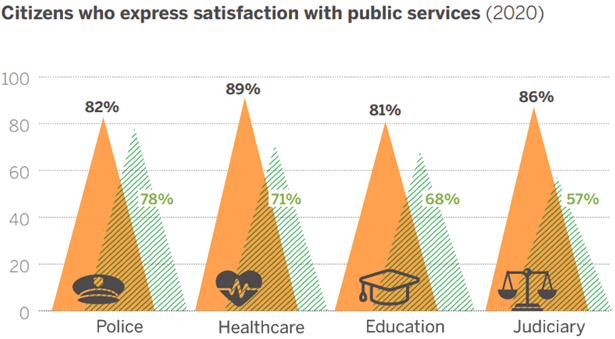
While there’s no provable direct link, the Danish government has some of the highest levels of citizen trust in the world. 72% of Danish citizens express trust in their government, compared to the OECD average of just 51%.
And beyond contributing to trust, Denmark’s digital-first strategy saves 296 million EUR ($317.7 million USD) annually and has reduced processing time by 30% across departments.
To learn about Denmark’s digitalization strategy and digital transformation initiatives, check out our blog How Denmark became a global leader in public sector digitalization.
Before we dive into the steps to achieve citizen-centric digital public services, there’s two core concepts every public service provider should understand. The first is the determinants of trust, and the second is the fundamentals of user experience (UX) design.
By combining an understanding of what creates trust with an understanding of what creates superior online experiences, you have a recipe for trust-building citizen-centric digital public services.
The OECD’s 5 core determinants of trust are:
- Responsiveness: Provide or regulate public services.
- Reliability: Anticipate change, protect citizens.
- Integrity: Use power and public resources ethically.
- Openness: Listen, consult, engage, and explain to citizens.
- Fairness: Improve living conditions for all.
When citizens use digital public services, they’re no longer just citizens, they become users. And just like Maslow’s hierarchy says we need food and shelter before we can achieve self-actualization, UX designer Aarron Walter explains that users need the foundations of services to be in place before they can be considered pleasurable.
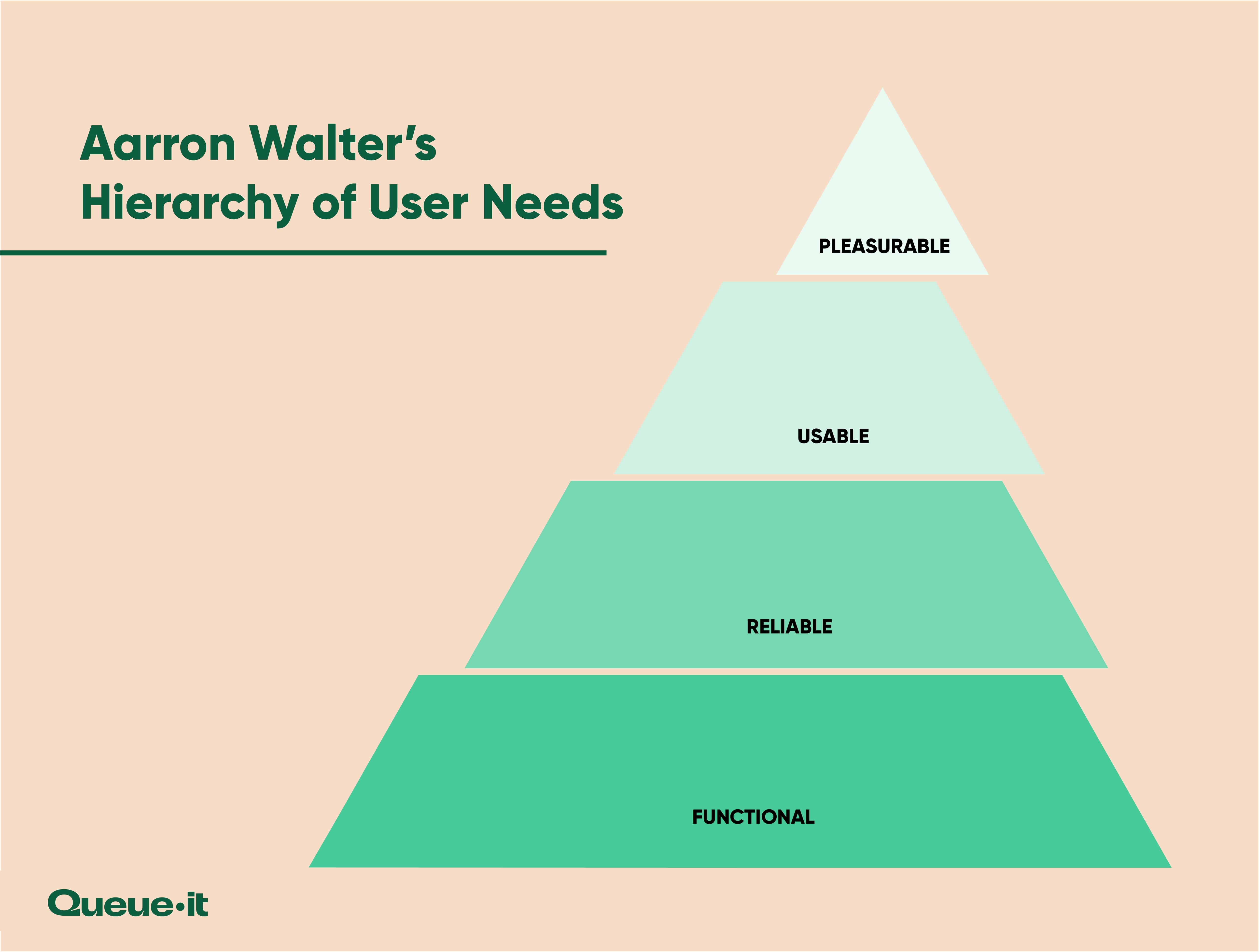
Here’s a quick and simple explanation of what each of the tiers on the user needs hierarchy means:
- Functional: The service must work or there’s no point in its existing.
- Reliable: The service must work reliably, as citizens need to be able to count on it when it matters most.
- Useable: The service should be simple, highly accessible, and easy to use for people from all backgrounds.
- Pleasurable: This is what all public services should strive for—intuitive, aesthetic, seamless services that make citizens think “my government worked for me.”
For a deeper dive into these 4 user needs and how they apply to public sector websites, check out our blog Public sector digital transformation & the citizen experience.
Now you understand the basics, let’s look at how the determinants of trust and the user needs hierarchy inform 4 proven steps to improving digital public services.
To improve digital public services, governments need to prioritize clear, open, two-way communication.
Openness and responsiveness are two of the OECD’s five key drivers of trust. They’re also key to user experience design, as they contribute to highly usable and pleasurable services.
While two-way communication is at the heart of UX design, it’s rarer than it should be in government. It involves listening to citizens, engaging, and consulting with them, and pursuing ways to communicate with them effectively.
This usually involves things like focus groups, surveys, feedback forms on sites, and gathering and analyzing data for user research.
Trust in government is significantly higher among citizens who give feedback (46%), and those who receive a response with information (62%). What’s more, 70% of citizens want to engage in the development of federal services.
Two-way communication enables:
- A deeper understanding of the needs of citizens
- Expectation setting for service delivery
- Increased participation and engagement opportunities
- Preparing citizens for service delivery to boost efficacy and efficiency
- An improved public understanding of what the government is doing and why
Public service providers that don’t understand the needs of citizens or communicate with them effectively create a disconnect between their service and the citizens for whom it’s designed.
Poor communication perpetuates the notion that governments are bureaucratic and difficult to deal with. It leads to situations where governments release convoluted programs that make perfect sense to the people who made them, but are an undecipherable maze to regular citizens just looking to get a vaccine, vote, or file their taxes.
In short, without communication, citizens are left frustrated and confused when they’re just trying to perform their civic duty.
This was the case during the 2016 election, where strict voter registration rules meant 125,000 Brooklyn voters were removed from rolls, discovering they needed to declare themselves as Republican or Democrat months in advance. As one New York resident told The Guardian:
“I’m one of the many Brooklynites who found his name inexplicably taken off the rolls when I tried to vote. Prior to today, I never felt the need to check my eligibility […] I am outraged by this situation and feel that this really undermines the credibility of our government.”
Stories like this abound in public service delivery. During vaccination registrations, voter registrations, and unemployment registrations, unclear communication regularly frustrates citizens and threatens the uptake of services.
Citizen-centric public service delivery means governments need to not only effectively communicate with citizens but also listen to them, gather feedback, and work hard to improve services.
Two-way communication empowers citizens to have their say. It’s a democratic process that enables governments to engage and understand citizens, as well as develop services that actually “serve” citizens’ needs.
RELATED: The Big Challenge to Government’s Digital Transformation
Digital public services need to be designed with every citizen in mind. The government exists for its citizens, but digital services are often only accessible to a subset of the population.
According to Pew Research Center, a massive 30% of Americans have lower tech readiness. Someone is considered low on tech readiness if they say they’re “not at all” or “only a little” confident using computers, smartphones, or devices to do things online, or if they say they usually need help using computers and devices.
Those with lower education and income are less likely to have confidence using new technologies, as are those 50 years of age and older.
Pew Research Center’s data on low tech readiness and is highly correlated with its data on reported levels of trust. Their surveys show that the lower a citizen’s education and salary, the less likely they are to be confident using tech, and the less trusting they are likely to be.
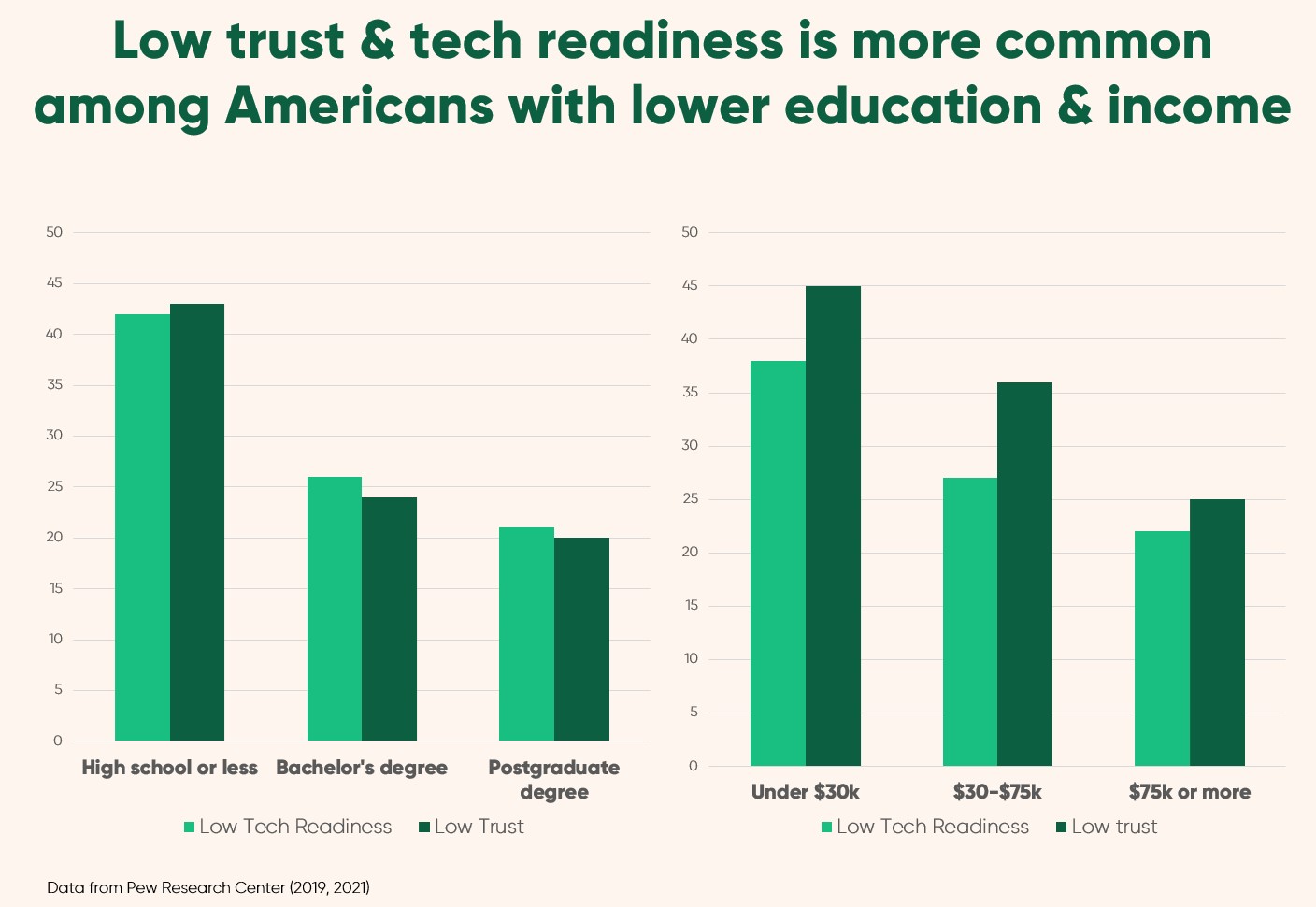
A 2020 report from the Economic Policy Institute sheds light on one reason this might be the case.
In this survey of 25,000 citizens, for every 10 people who successfully applied for unemployment insurance there were 2 who didn’t apply because it was too difficult, and 3.7 who tried to apply but couldn’t get through.
That’s 36% of applicants not managing to apply for benefits they may be owed because of difficulties accessing the service.
Can you imagine if 36% of people failed to buy products from Amazon, or to set up their iPhone? The companies would go bust.
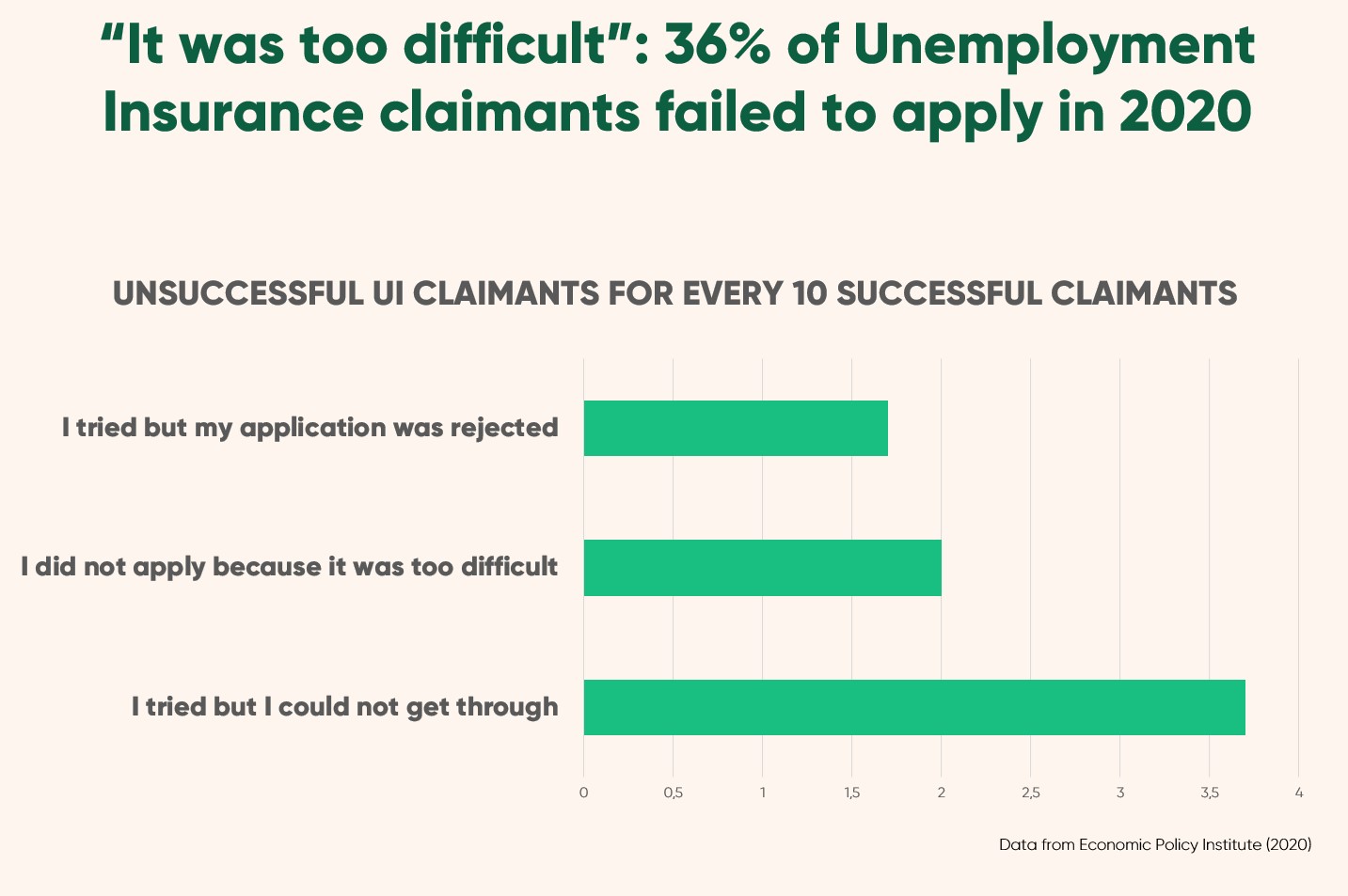
This Economic Policy Institute and Pew Research Center data points to a key problem in digital public service delivery: the people who need government support the most are often those who have the hardest time accessing it.
In a recent The Atlantic article, Annie Lowrey argues that government benefits and subsidies for the wealthy are easier to access than those for the poor. She provides many examples of citizens needing to jump through hoops to access food stamps, unemployment insurance, child tax credit, and rental assistance.
One of the most astoundingly irrational examples Lowrey offers is:
“California has a program to provide low-income state residents with reduced-price ID cards through the DMV. To take advantage of the benefit, a person needs to fill out one Form DL 937. Individuals cannot access and fill out this PDF themselves, however. It is not posted online. Instead, applicants have to do so through a “qualified verifier of income,” such as a social worker at a homeless shelter.”
Digital public services examples like this get at the heart of why user experience design is so crucial to trust: it enables governments to deliver on their promises to citizens.
Many lofty and virtuous initiatives fail because the people who need them most don’t understand how to access them. Particularly because those with low incomes are more likely to struggle with tech.
When asked what frustrated them most when digitally accessing government services, citizens responded:
- Slow or unclear processes (74%)
- Unavailable or ineffective customer support (59%)
- Digital tools that were hard to use or did not work well (34%)
The useability of government websites is highly associated with perceived credibility of the government. So, to build trust and facilitate uptake among all citizens, user experience insights need to be at the core of digital service design and digital transformation.
Designing for everyone is closely related to creating two-way communication. It’s about gathering feedback, data, and continually testing to improve service delivery in a more tailored way. Some common best practices for improving usability include:
- Seek universal usability by recognizing citizens’ diverse needs
- Ensure the service is fair for all citizens
- Strive for consistency to make processes more intuitive
- Design to make errors difficult or impossible
- Allow easy reversal of actions
- Reduce short-term memory load
These UX insights should be incorporated into public service delivery to reduce confusion, anxiety, and disappointment among citizens trying to get register for essential services.
Acting on UX expertise and research will facilitate easier and more satisfying registrations for citizens. Services that leave little to no room for error and confusion are services that reduce the load on case-handling, citizen-service centers, and citizens’ time. This not only drives trust in the competency of government but also improves the accessibility of digital services and saves resources.
Fairness is an essential ingredient of digital public services that inspire trust and create satisfied citizens.
Fairness and integrity are two of the OECD’s key drivers of trust, and an important element of making services a pleasure to use. In one study, fairness was found to explain 80% of consumers reported trust in online businesses.
RELATED: Customer Loyalty in Ecommerce: The Surprising Benefits of Fairness
Digital public services make life fairer for citizens. They offer access to citizens in regional areas, those working long hours, those with disabilities. They bring the public service into the homes of millions of citizens.
Yes, certain groups lack important access and are less confident with technology. But digital service delivery still provides more access to services to more people on more equal terms.
In situations where demand exceeds supply, however, digital service delivery often becomes unfair.
During the vaccine rollout, for example, people hacked booking systems, used bots to beat out others, created notification systems to give them first access to open slots, and even worked as vaccine hunters for hire, selling their services to give people a better shot at access.
RELATED: 6 Ways to Improve COVID-19 Vaccination Registrations
Who does this disadvantage?
The elderly, those with low tech readiness, and essential workers.
Fairness is a crucial element of public service delivery. Not just because of the data on trust or because it makes services more likely to be used—because it’s the right thing to do.
No citizen should have a lower chance of getting a life-saving vaccine just because they didn’t study computer science or can’t afford a vaccine hunter.
Online fairness has always been our mission at Queue-it, and we’ve been working with public and private sector organizations for over a decade to deliver fairness to customers and citizens. Along the way, we’ve learned a few key strategies to make service delivery fairer.
Some best practices for creating online fairness for high-demand digital services include:
- Establish fixed times when bookings are made available, so citizens know when they need to visit the site.
- Allow citizens to register their information ahead of time, so slower users aren’t disadvantaged.
- Give everyone an equal chance using a randomized queue when registrations go live, then create fairness with a first-in, first-out system for those who join later.
- Use bot mitigation tools to prevent unfair advantages for the tech-savvy.
- Offer those who missed out the option to sign up for email or phone notifications of available bookings in the event of cancelations.
- Offer non-digital systems for registrations, such as phone lines and walk-in clinics, so those without internet or phones still have access to public services.
- Work on centralized systems for registrations to make service delivery more accessible and easier to navigate.
RELATED: Keeping the Internet Fair: Queue-it’s Commitment to Online Fairness
Services that citizens can count on need to work, and work reliably. A reliable service is one citizens can depend on to consistently fulfill its purpose.
Reliability is both one of the OECD’s top drivers of trust, and among the foremost foundations of user needs.
Citizens turn to governments for essential services—they need to trust these services to be available and reliable.
Digital services that falter and fail impact the perceived competence of government. And yet year-round, across the globe, public sector services and sites suffer crashes, outages, slowdowns, and errors.
This graphic from The Markup perfectly captures the contrasting forces of citizens performing their civic duty and failures in public service delivery during voter registrations. The article cites crashes for voter registrations across Pennsylvania, Florida, Virginia, Georgia, and New York.
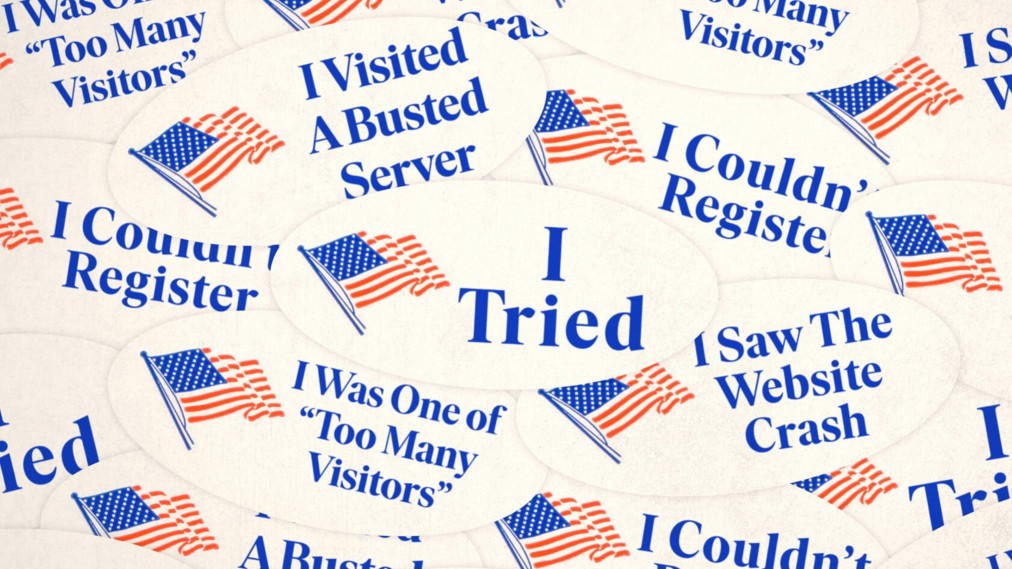
Ryan Snow from the Lawyer’s Committee for Civil Rights under Law told The Markup:
“If you’re not maintaining critical infrastructure and it results in people not being able to vote, that’s voter suppression by inaction.”
But it isn’t just voter registration that crashes public sector sites. Crashes hit agencies and departments across government. We’ve seen them in taxes, unemployment filing, healthcare, parks and recreation, vaccination registrations, even military sites.
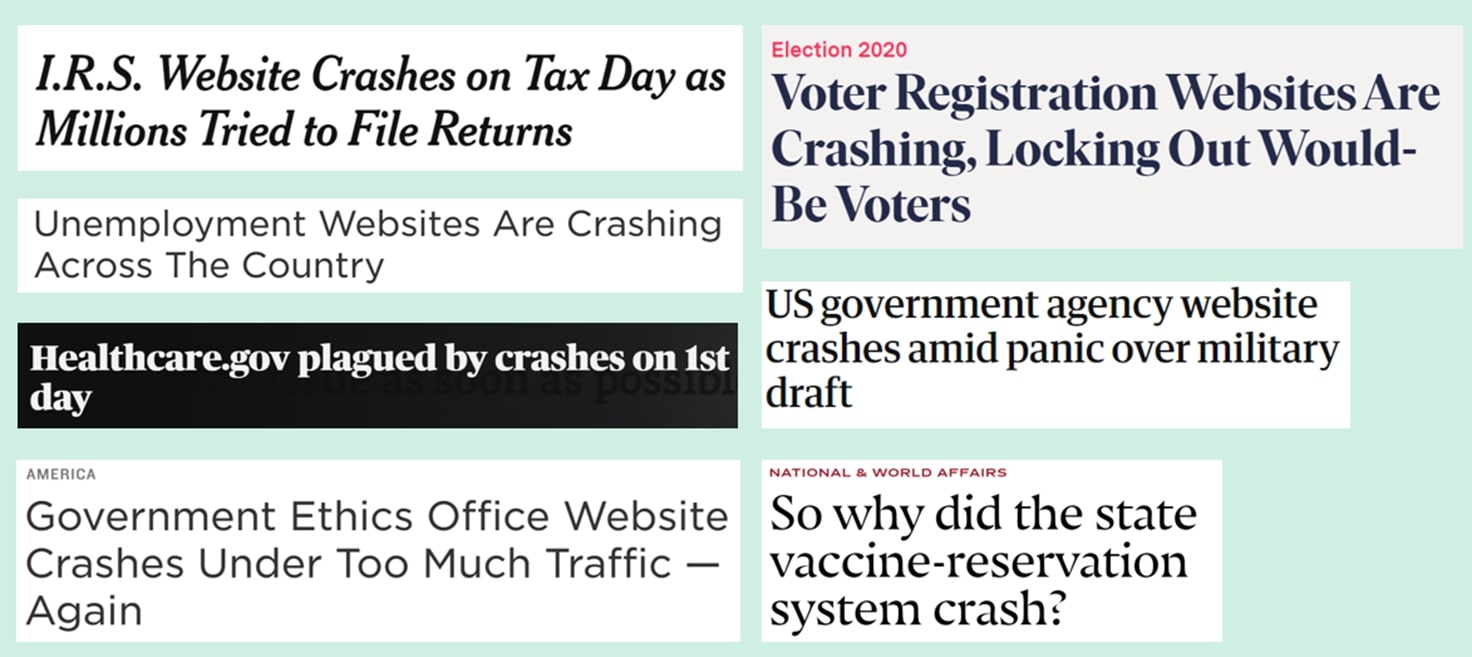
RELATED: Prevent Government Website Crashes by Controlling Traffic
If you remember the 2013 launch of Healthcare.gov, you know the impact these site crashes can have. After a massive lead up from the Obama administration, the Healthcare.gov site went live and crashed almost immediately. On the first day, 250,000 visited the site. And by the day's end, only six had successfully completed applications.
This is what’s called a liability. Citizen-centric service delivery requires turning liability into reliability.
But creating reliable services is complex. It involves developing services that can scale, testing them to keep them bug-free, and ensuring they perform quickly and smoothly. And all this must be true 24 hours a day, 7 days a week, 365 days a year.
The three main causes of website crashes and IT downtime are: usage spikes, network failure, and human error. For public sector services, usage spikes are the worst culprit because they occur when government service providers are at their most visible.
RELATED: The Cost of Downtime: IT Outages, Brownouts & Your Bottom Line
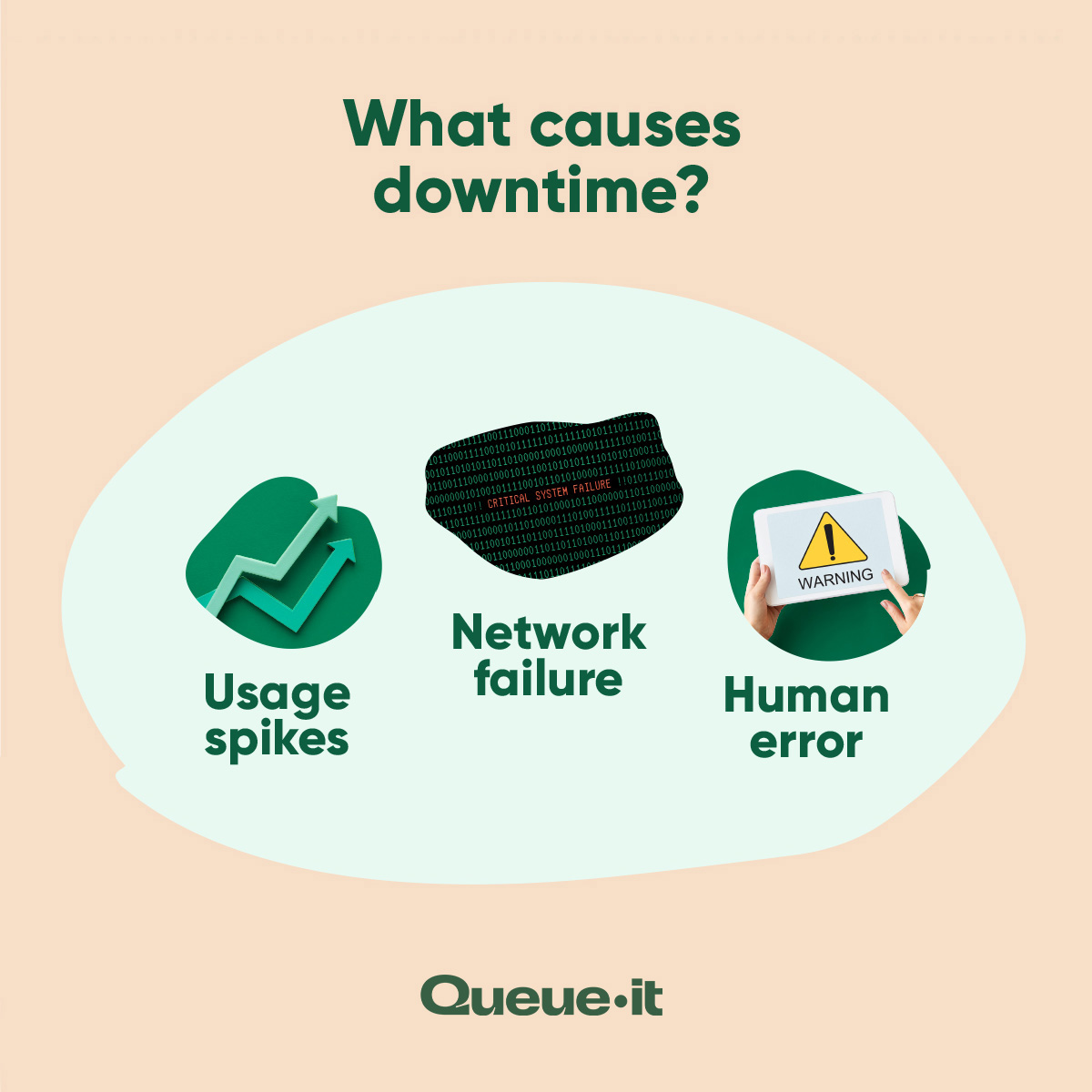
We have a term for usage spikes in government services here at Queue-it: The “Press conference effect”.
Here’s a behind-the-scenes look at the press conference effect in action. For this public sector client, a press conference announcing COVID-19 booster shots were available saw traffic shoot from about 400 visitors per minute to over 2,500 visitors per minute.
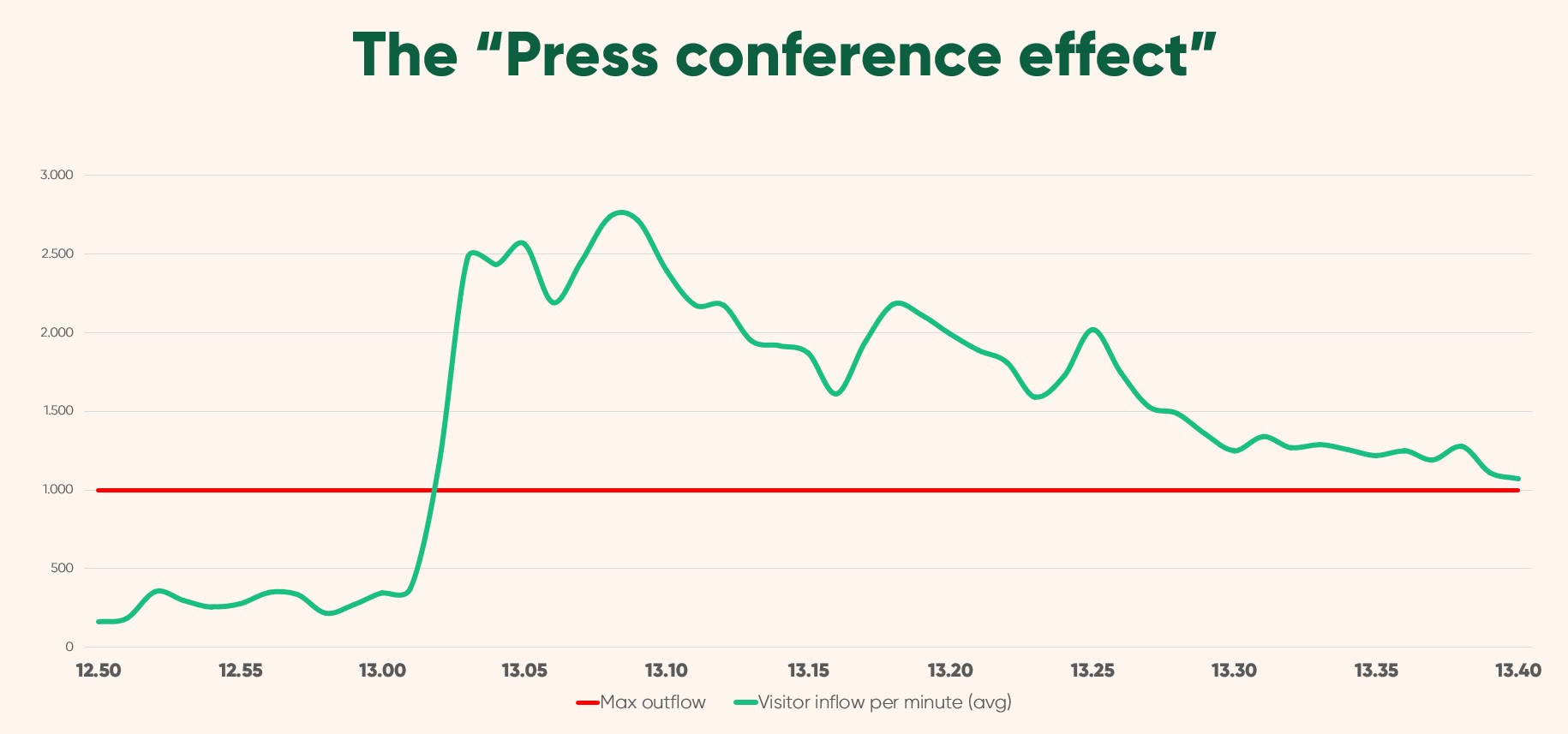
The red line is the maximum number of users the site can handle—1,000. That green line is the number of visitors to the site. The 2,500 visitors accessing the site each minute was more than double what the site could handle.
When the Newfoundland and Labrador Centre for Health Information launched their vaccine portal, they faced a similarly threatening traffic surge:
“When we went live, we saw huge amounts of traffic all at once. We had thousands and thousands of people every second trying to come in and get their vaccine records. Our go live lasted for about two hours and then our backend systems became overwhelmed. We were definitely in a high stress situation the day we went live.”
Andrew Roberts, Director of Solution Development & Support, NLCHI
We worked with the NLCHI after their rocky go live to implement a virtual waiting room and ensure they could deliver the reliability citizens deserved.
A virtual waiting room enables organizations to control online traffic to keep websites online and ensure a fair and seamless user experience, no matter the demand. Simply put, it enables organizations to handle sudden spikes in traffic or enormous load on their infrastructure without sacrificing the user experience.
After the NLCHI implemented the virtual waiting room, Roberts said: “After all the panic and the media attention, it was such a sense of relief to have Queue-it in place. We could see that traffic was going to the virtual waiting room and the number of people downloading their vaccine records was climbing quickly. It just felt like ‘Okay, we’re back up and running.’”
A virtual waiting room is an important tool in your crash prevention toolkit, but there are others you should use to complement the solution. These include:
- Load testing your site ahead of major sales days to know what you can handle
- Cache static content on your CDN and run content on the Edge
- Identify site bottlenecks such as payment gateways and database calls
- Scale up your servers and configure autoscaling
Creating citizen-centric digital services is like keeping your service centers clean and ensuring staff are polite and helpful—it’s about creating a superior experience for citizens and demonstrating the competence of government.
The benefits are many. Well-designed digital public services can save governments time and money, increase staff and citizen satisfaction, and boost trust and credibility.
To reap these benefits, services need to be designed with the user/citizen experience and the determinants of trust at their core. This means creating functional, reliable, usable, and pleasurable services (from The Hierarchy of User Needs). As well as ensuring services and digital transformation initiatives project responsiveness, reliability, integrity, openness, and fairness (from the OECD’s Determinants of Trust).
UX research and findings on trust inform 4 proven steps to improve digital public services:
- Engage in clear, open, two-way communication
- Design for everyone
- Make fairness a priority
- Create services citizens can count on
While these steps are simple in principle, they’re both complex to implement and powerful in their potential.
As we see in countries like Denmark, creating world-leading citizen-centric services is not an overnight process, or one that can be achieved alone. It takes years, requires support from colleagues and higher-ups, and involves collaboration with citizens and private companies.
But digitalization pays dividends. And a citizen-centric government ethos enables the public sector to fulfill one of its foremost duties—serve its citizens.